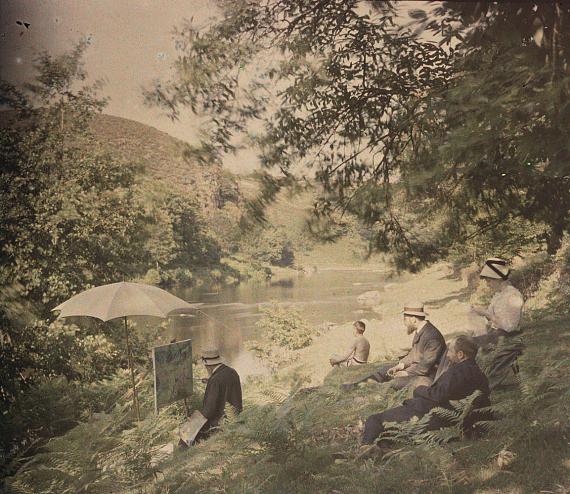
Armand Guillaumin Painting "Bathers near Crozant", ca. 1907
Autochrome (exhibited in facsimile)
9 x 12 cm
© Société française de photographie, Paris
A New Art: Photography and Impressionism
Eine neue Kunst. Photographie und Impressionismus
Olympe Aguado » Eugène Cuvelier » Alphonse Davanne » Louise Deglane » Robert Demachy » Peter Henry Emerson » Hugo Henneberg » Heinrich Kühn » Jacques-Henri Lartigue » Gustave Le Gray » Henri Le Secq » Charles Marville » Emile J. Constant Puyo » Henry Peach Robinson » Alfred Stieglitz » & others
Exhibition: 12 Feb – 8 May 2022
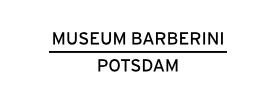
Museum Barberini
Humboldtstr. 5–6
14467 Potsdam
+49 (0)331-236014-499
info@museum-barberini.de
www.museum-barberini.de
Mon-Fri 10-19
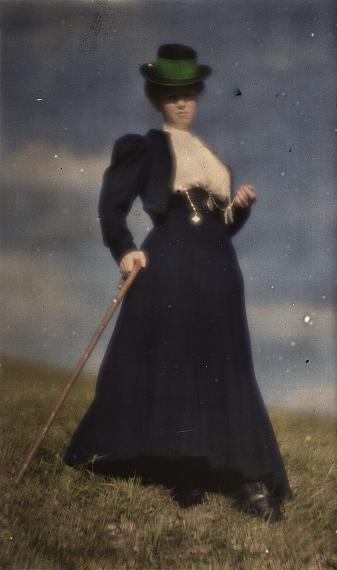
Miss Mary Warner, 1910
Autochrome
24 x 18 cm
Österreichische Nationalbibliothek, Vienna
© ÖNB/Kühn
"A New Art: Photography and Impressionism"
Exhibition: 12 February — 8 May, 2022
In the nineteenth century, numerous photographers chose the same motifs as
impressionist painters: the forest of Fontainebleau, the cliffs of Étretat, or
the modern metropolis of Paris. They too studied different light effects, the passing
of the seasons, and changing weather conditions. Experimenting with composition
and perspective and using a range of different techniques, photography had
an artistic ambition from its beginnings. Until the First World War, its relationship
to painting was shaped both by competition and influence. Featuring more
than 150 works, the exhibition at the Museum Barberini explores photography’s
development to an autonomous art form and illuminates its complex relationship
to impressionist painting.
The new medium of photography was linked to both the industrial revolution and the
advent of a modern knowledge society. At the world’s fairs it was presented to an
international public. Photographic exposure and reproduction techniques served the
panoramic vision of the period and answered an encyclopedic desire to document.
The possibility of creating collections of any conceivable theme through photographs
corresponded to a new need to make knowledge accessible and to archive it. Similar
to the way in which the city centers of Paris, London, Vienna, or Munich were transformed
by historicizing architecture, the new medium also fused tradition and modernity:
museums, libraries, and archives were built, travelogues, surveys, and maps shaped the
era. At the same time as sociology became a subject, social documentary photography
emerged alongside novels of social realism. The natural sciences, which were now
becoming separate disciplines, described the present.
So what seemed more natural than to exploit photography’s exactitude? Might the new
medium become an auxiliary science of painting? In 1859, Charles Baudelaire wrote
a scathing critique of the first Paris Salon to include photographs. In a fictional dispute, he had a photographer say, "I want to represent things as they are, or rather as they would be, supposing that I did not exist." Against this, Baudelaire set the answer of a painter from his favored faction of 'imaginatives': "I want to illuminate things with my mind, and to project their reflection upon other minds." The antagonism between machine and mind established here by Baudelaire, a visionary and a friend of the impressionists, would continue for a long time. As late as 1936, Walter Benjamin’s reflections on the loss of the aura in "The Work of Art in the Age of Mechanical Reproduction" would return to this distinction.
Claude Monet, just like Berthe Morisot, Camille Pissarro, and Pierre-Auguste Renoir,
worked en plein air in order to explore the new relationship between humans and nature.
The impressionists devoted their works to the fleeting moment, to the here and now,
each capturing the changing light and weather phenomena in their own way. This made
them natural allies of the photographers. Choosing the same motifs as the impressionists,
photographers too studied shifting light and atmospheric conditions and the passing
of the seasons. From the beginning, they pursued their artistic ambitions by experimenting with composition and perspective, using different techniques and materials, and employing blurring effects, dramatization, and montage. Like vision itself, light—the basis of photography—was a shared theme of painting and photography.
Before Photography: Painting and the Invention of Photography at the Museum of
Modern Art in New York made it clear that photography did not emerge from a scientific
context but from landscape painting. The medium’s perspectival and subjective nature
has been a research focus ever since, and the insights gained from this enabled pivotal
exhibitions such as Gustave Caillebotte: An Impressionist and Photography (Schirn, Frankfurt am Main, 2012) and The Impressionists and Photography (Museo Nacional Thyssen-Bornemisza, Madrid, 2019).
Yet the interplay between photography and impressionism remains underresearched.
A New Art: Photography and Impressionism at the Museum Barberini aims to address
this gap. Featuring more than 150 works, including photographs by Stéphanie Breton,
Auguste Hippolyte Collard, Eugène Cuvelier, Louis-Alphonse Davanne, Robert Demachy,
Peter Henry Emerson, Gustave Le Gray, Henri Le Secq, Heinrich Kühn, Charles Marville,
Constant Puyo, Henry Peach Robinson, Alfred Stieglitz, Carl Teufel, and Alphonse Taupin,
the exhibition illuminates the development of the new medium. Important loans have
been made by the Albertina in Vienna, the Serge Kakou Collection in Paris, the Münchner
Stadtmuseum, Musée d'Orsay in Paris, Museum Folkwang in Essen, Photoinstitut
Bonartes in Vienna, Société Française de Photographie in Paris, Staatliche Museen zu
Berlin, the Staatsgalerie Stuttgart, and many other institutions.
Photography and Impressionism is the first photography exhibition to be shown
at the Museum Barberini since its opening in 2017. Its point of departure is the collection of impressionist and post-impressionist paintings by museum founder Hasso Plattner, which has been on permanent display since September 2020 and includes numerous
works by artists like Gustave Caillebotte, Claude Monet, or Berthe Morisot. The Von der
Heydt-Museum in Wuppertal, which will present the show from October 2, 2022 to
January 8, 2023 in cooperation with the Museum Barberini, is one of the institutions that
began to collect impressionist art early on, setting an example in both Germany and
Europe overall.
The exhibitions in Potsdam and Wuppertal are accompanied by a comprehensive catalog
published by Prestel, Munich, with contributions by Ulrich Pohlmann, Monika Faber,
Dominique de Font-Réaulx, Matthias Krüger, Esther Ruelfs, and Bernd Stiegler, which are
based on the findings of the preparatory symposium held in Potsdam in October 2021.
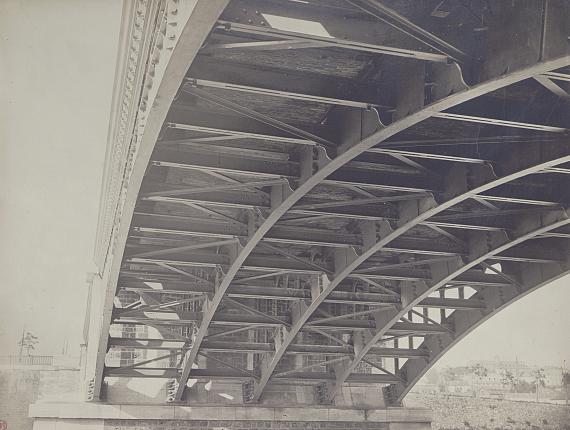
Pont de Grenelle, Paris, ca. 1875/76
Albumen print
34 x 42 cm
Bibliothèque de l’École nationale des Ponts et Chaussées, Marne-la-Vallée
© École nationale des Ponts et Chaussées
"Eine neue Kunst. Photographie und Impressionismus"
Ausstellung: 12. Februar bis 8. Mai 2022
Im 19. Jahrhundert wählten zahlreiche Photographen die gleichen Motive wie die
Maler des Impressionismus: Den Wald von Fontainebleau, die Steilküste von Étretat
oder die moderne Metropole Paris. Auch sie studierten die wechselnden Lichtsituationen,
die Jahreszeiten und Wetterverhältnisse. Von Anfang an verfolgte die Photographie
durch Erprobung von Komposition und Perspektive sowie mit Hilfe unterschiedlicher
Techniken einen künstlerischen Anspruch. Ihr Verhältnis zur Malerei war bis zum
Ersten Weltkrieg sowohl von Konkurrenz als auch von Einflussnahme geprägt. Die
Ausstellung im Museum Barberini untersucht mit über 150 Werken die Photographie
um 1900 auf ihrem Weg zu einer autonomen Kunstform und beleuchtet ihr komplexes
Verhältnis zur impressionistischen Malerei.
Das neue Medium der Photographie war zugleich Teil der industriellen Revolution und
Beginn der modernen Wissensgesellschaft. Auf den Weltausstellungen wurde es einem
internationalen Publikum vorgestellt. Die photographischen Aufnahme- und Reproduktionstechniken bedienten sowohl den zeitspezifischen Blick als auch den enzyklopädischen Dokumentationswillen: Die Möglichkeit, mit Photographien Sammlungen beliebiger Themengebiete anzulegen, entsprach dem neuen Bedürfnis, Wissen zugänglich zu machen und zu archivieren. Wie die umgestalteten Stadtzentren von Paris, London, Wien oder München im Historismus der Architektur, so brachte auch das neue Medium Tradition und Moderne zusammen: Museen, Bibliotheken und Archive entstanden, Reisebeschreibungen,
Vermessung und Kartierung prägten das Zeitalter. Parallel zur Soziologie entstand neben
dem Gesellschaftsroman des literarischen Realismus die Sozialreportage in der Photographie. Die sich ausdifferenzierenden Naturwissenschaften beschrieben die Gegenwart.
Was lag somit näher, als die Exaktheit der Photographie zu nutzen? Sollte sich gar das
neue Medium zu mehr als einer Hilfswissenschaft der Malerei entwickeln? Zum ersten
Pariser Salon, auf dem auch Photographien ausgestellt wurden, schrieb Charles Baudelaire
1859 eine vernichtende Kritik. In einem fiktiven Streitgespräch ließ er einen Photographen sagen: "Ich will die Dinge so wiedergeben, wie sie sind, oder besser: wie sie wären, wenn ich nicht da wäre." Dagegen setzte Baudelaire die Antwort eines Malers aus der von ihm favorisierten 'Gruppe der Phantasiereichen': "Ich möchte die Dinge durch meinen Geist erleuchten und ihren Widerschein auf die anderen Geister abstrahlen." Damit legte Baudelaire, Vordenker und Freund der Impressionisten, den Antagonismus zwischenMaschine und Geist auf lange Sicht fest. Noch Walter Benjamins Überlegungen zumVerlust der Aura des "Kunstwerks im Zeitalter seiner technischen Reproduzierbarkeit" aus dem Jahr 1936 geht auf diese Unterscheidung zurück.
Claude Monet wie Berthe Morisot, Camille Pissarro und Pierre-Auguste Renoir arbeiteten
unter freiem Himmel, um die neue Beziehung von Mensch und Natur zu thematisieren.
Die Impressionisten widmeten ihre Malerei dem Augenblick. Ihre Malerei war pure Gegenwart, die individuelle Reaktionen auf im Wechsel begriffene Licht- und Wetterphänomene thematisierte. Das machte sie zu Verbündeten der Photographen. Auch sie wählten die gleichen Motive wie die Impressionisten und studierten die wechselnden Lichtsituationen, Jahreszeiten und Wetterverhaltnisse. Von Anfang an verfolgten sie durch Erprobung von Komposition und Perspektive, mithilfe unterschiedlicher Techniken und Materialien sowie mit Unschärfe, Dramatisierung und Montage einen künstlerischen Anspruch.
Licht – Grundlage der Photographie – war wie das Sehen selbst gemeinsames Thema von
Malerei und Photographie. Die Ausstellung Before Photography. Painting and the Invention of Photography im New Yorker Museum of Modern Art verdeutlichte bereits 1981, dass die Photographie nicht aus dem Wissenschaftskontext hervorging, sondern aus der Landschaftsmalerei. Die Erforschung des perspektivischen und subjektiven Charakters
des Mediums stand seither im Fokus und ermöglichte so grundlegende Ausstellungen
wie Gustave Caillebotte. Ein Impressionist und die Fotografie (Schirn, Frankfurt am Main, 2012) und The Impressionists and Photography (Museo Nacional Thyssen-Bornemisza, Madrid 2019).
Das Wechselspiel von Photographie und Impressionismus ist jedoch immer noch
unzureichend erforscht. Eine neue Kunst. Photographie und Impressionismus im Museum Barberini setzt hier an und beleuchtet mit über 150 Arbeiten, darunter Photographien von Stéphanie Breton, Auguste Hippolyte Collard, Eugène Cuvelier, Louis-Alphonse Davanne, Robert Demachy, Peter Henry Emerson, Gustave Le Gray, Henri Le Secq, Heinrich Kühn, Charles Marville, Constant Puyo, Henry Peach Robinson, Alfred Stieglitz, Carl Teufel und Alphonse Taupin, die Entwicklung des neuen Mediums. Bedeutende Leihgaben steuern die Albertina, Wien, Collection Serge Kakou, Paris, Münchner Stadtmuseum, Musée d’Orsay, Paris, Museum Folkwang, Essen, Photoinstitut Bonartes in Wien, Societe Francaise de Photographie, Paris, Staatliche Museen zu Berlin, die Staatsgalerie Stuttgart und viele weitere Institutionen bei.
Das 2017 eröffnete Museum Barberini zeigt mit Eine neue Kunst. Photographie und
Impressionismus erstmals eine Ausstellung mit Photographien. Ausgangspunkt für dieses Thema ist die Sammlung impressionistischer und postimpressionistischer Gemälde
des Museumsstifters Hasso Plattner, die seit September 2020 dauerhaft in Potsdam
präsentiert wird und zahlreiche Anknüpfungspunkte bei Künstlerinnen und Künstlern
wie Gustave Caillebotte, Claude Monet und Berthe Morisot bietet. Das Von der Heydt-
Museum, das in Kooperation mit dem Museum Barberini die Schau vom 2. Oktober 2022
bis 8. Januar 2023 in Wuppertal zeigt, gehört zu jenen Häusern, die schon früh
impressionistische Kunst sammelten und damit nicht nur in Deutschland, sondern in
Europa Zeichen setzten.
Zu den Ausstellungen in Potsdam und Wuppertal erscheint bei Prestel, München, ein
umfangreicher Katalog mit Beiträgen von Ulrich Pohlmann, Monika Faber, Dominique de Font-Réaulx, Matthias Krüger, Esther Ruelfs und Bernd Stiegler, die auf den Erkenntnissen des die Ausstellungen vorbereitenden Symposiums im Oktober 2021 in Potsdam fußen.
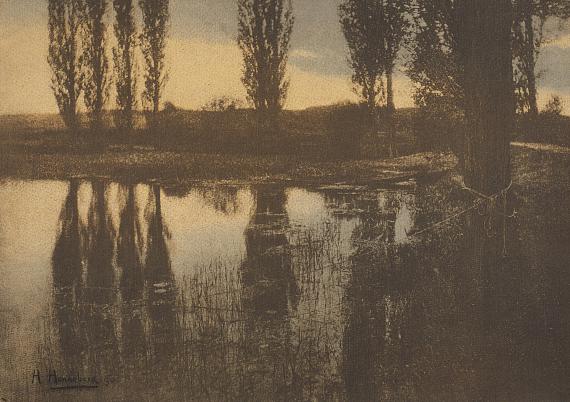
After Sunset, 1898 or earlier
Gum bichromate
36 x 51 cm
© Photoinstitut Bonartes, Vienna
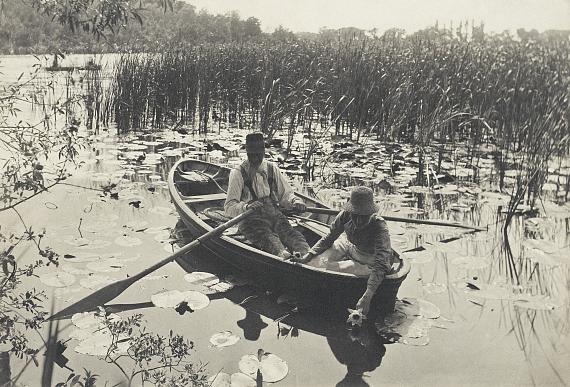
Gathering Water Lilies, 1886
Platinum print
19,5 x 29 cm
Staatsgalerie Stuttgart, Graphische Sammlung, acquired 1989, Rolf Mayer Collection, Stuttgart
© Photo: bpk / Staatsgalerie Stuttgart / Peter Henry Emerson